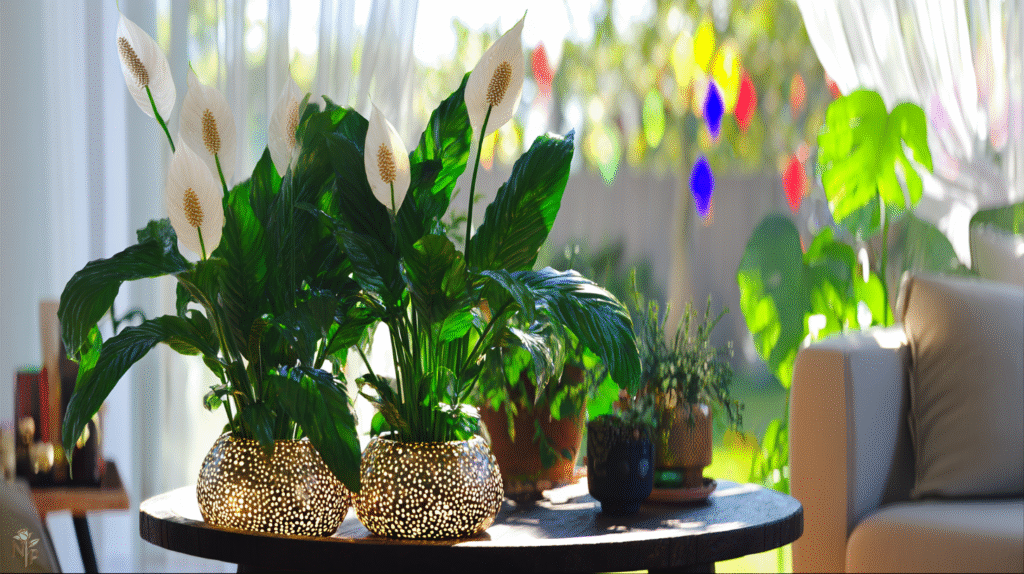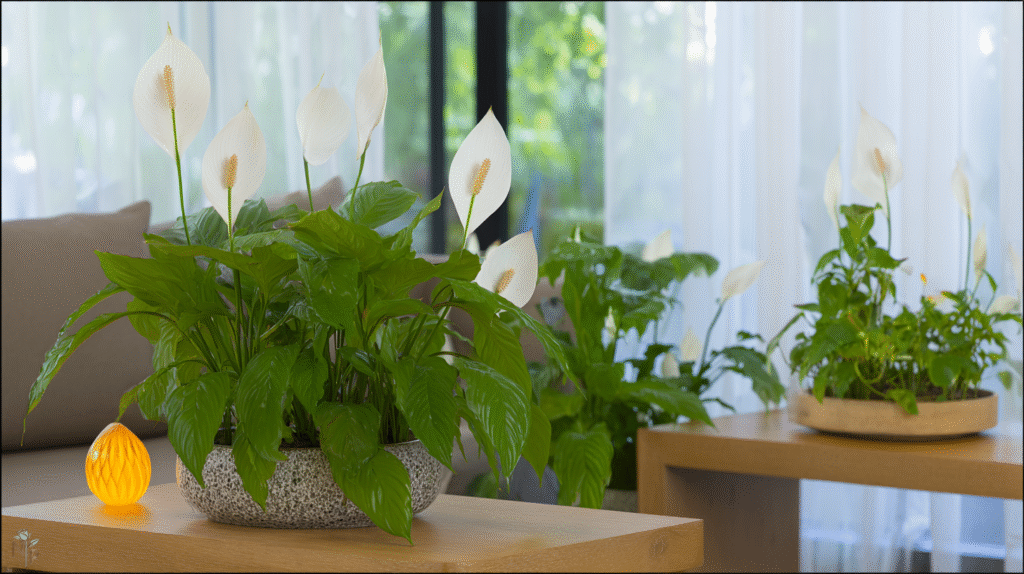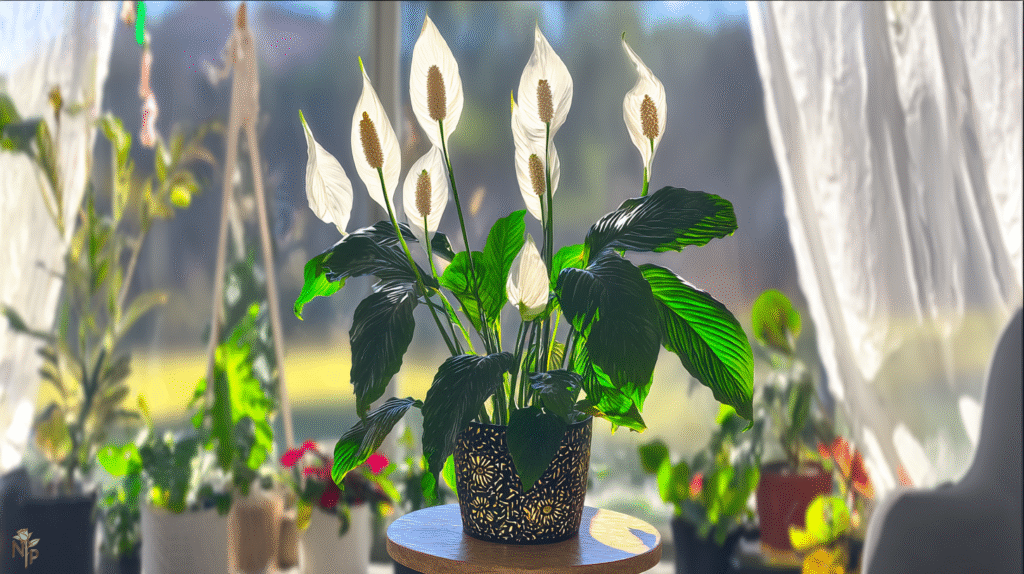My mother-in-law gave me a peace lily as a housewarming gift with this warning: “Even you can’t kill this one.” Challenge accepted, apparently, because I nearly murdered it within two weeks.
The leaves were drooping so dramatically it looked like it was melting. Black tips everywhere. The white flower turned green then brown. I was about to throw it out when my neighbor saw it through the window and literally knocked on my door to stage an intervention.
“That plant’s not dying,” she said, “it’s just being dramatic. Give it water and it’ll perk up in an hour.” She was right. One hour after watering, it looked like nothing had happened. That was three years ago. That same peace lily is now so big I had to split it into three plants, and I’ve given away probably ten babies to friends.
Here’s why peace lilies are actually the perfect gift plant (once you understand their drama queen tendencies) and exactly how to keep them happy without losing your mind.
Why Peace Lilies Are Actually Genius Gift Plants
Look, nobody wants to receive a plant that’ll die in a week and make them feel guilty. Peace lilies are perfect because:
They literally tell you when they need water by drooping. It’s like having a plant with a built-in alarm system. No guessing, no moisture meters, just look at it. Droopy = thirsty. Not droopy = leave it alone.
They bounce back from near death better than any plant I’ve owned. Forgot to water for three weeks while on vacation? Hour after watering, it’s fine. Overwatered and the leaves went yellow? Let it dry out, it recovers. It’s basically the plant equivalent of a Nokia phone.
They actually clean your air. NASA studied this (yes, NASA cares about houseplants). Peace lilies remove benzene, formaldehyde, and other crap from your air. So you’re not just giving a plant, you’re giving a living air purifier that happens to be pretty.

The Watering Drama (And How to Handle It)
Peace lilies are the theater kids of the plant world. They don’t just get thirsty – they perform an entire death scene.
The drooping act: When my peace lily needs water, it doesn’t drop subtle hints. Every single leaf droops until the whole plant looks like it’s melting into the pot. First time this happened, I panicked. Gave it water expecting a slow recovery. Nope. Within an hour, it was standing at attention like nothing happened.
Now I actually wait for the droop. It’s foolproof. Slight droop? Water today. Dramatic full-plant collapse? Water immediately and watch the magic resurrection.
How much water: Water until it runs out the drainage holes. I mean really soak it. I take mine to the sink, water thoroughly, let it drain for 10 minutes, then put it back. In summer this is weekly. Winter? Every 10-14 days. But honestly, I just wait for the droop.
The overwatering trap: Only time I nearly killed mine for real was when I watered on a schedule instead of waiting for the droop. Leaves went yellow, soil stayed soggy, started smelling swampy. Let it dry out completely (took two weeks), and it recovered. Now I only water when it asks for it with the dramatic droop.
Light Requirements (Easier Than You Think)
Every care guide says “low to medium indirect light” which means absolutely nothing useful. Here’s what actually works:
My peace lily lives 6 feet from a north-facing window. Gets zero direct sun, ever. Still blooms twice a year. My friend has hers in a bathroom with just a frosted window. Also thriving.
But here’s the thing – “tolerates low light” doesn’t mean “prefers darkness.” I had one in my windowless office under fluorescent lights. It survived but never bloomed and grew super slowly. Moved it to the living room with actual daylight (not even direct sun), and boom – flowers within a month.
The sweet spot: Near any window but not in direct sun. Direct sun = crispy brown leaves. I learned this when I moved mine outside for “fresh air” one summer day. Two hours later, sunburned plant. They’re shade plants in nature, growing under tree canopies. Treat them like vampires – they like light but not actual sunshine.
The Flower Situation Nobody Explains
Those white “flowers” aren’t actually flowers – they’re modified leaves called spathes. The real flower is that bumpy spike thing in the middle. Mind blown, right?
New peace lilies often come with flowers that last for months. When they finally turn green then brown, cut them off at the base of the stem. I was scared to cut mine at first, left the dead flowers on for weeks. Looked terrible. Finally cut them, plant immediately grew new leaves.
Getting it to re-bloom: Mine blooms reliably twice a year – spring and fall. The secret? I do absolutely nothing special. No fancy fertilizer, no special treatment. Just consistent care and enough light. If yours won’t bloom, it needs more light. Move it closer to a window (but still no direct sun).
Some people swear by giving it a cool period or feeding it special bloom fertilizer. Tried both. Made no difference. Light is the only thing that matters for blooms in my experience.
Temperature and Humidity (They’re Picky But Not That Picky)
Peace lilies are supposedly tropical plants that need warmth and humidity. Mine lives in my dry, drafty apartment that swings from 62°F at night to 74°F during the day. Still thriving.
What actually matters: Keep them above 60°F. That’s it. Mine survived a night at 55°F when our heat broke. Wasn’t happy but didn’t die.
Humidity helps but isn’t essential. The tips of my leaves get brown in winter when the heat’s blasting and humidity is 25%. Does it look perfect? No. Does it care? Also no. If the brown tips bother you, trim them with scissors. I gave up and just accept that winter = crispy tips.
The bathroom myth: Everyone says put them in the bathroom for humidity. Great if you have a bathroom with a window. Mine doesn’t, and peace lilies need more light than a windowless bathroom provides, no matter how steamy your showers are.

Common Problems That Aren’t Actually Problems
Brown leaf tips: Usually tap water chemicals or low humidity. Switch to filtered water if you’re fancy. I’m not, so I just trim the brown bits and move on.
Yellow leaves: Old leaves turn yellow and die. It’s normal. If it’s just one or two bottom leaves, pick them off. If it’s many leaves, you’re probably overwatering.
Green flowers: Flowers naturally turn green as they age. It’s not a problem, just means they’re old. Cut them off when they look ugly.
No flowers: Needs more light. That’s literally always the answer. Mine didn’t bloom for a year in a dark corner. Moved it closer to window, bloomed within six weeks.
Why I Give These as Gifts Now
I’ve given away probably fifteen peace lilies over the years. Every single person still has theirs alive. Even my brother, who killed a cactus.
They’re forgiving enough for beginners but interesting enough for plant people. They’re safe around pets (toxic if eaten but my cat took one nibble and never touched it again). They actually improve air quality. And they’re dramatic enough to be entertaining – watching them droop and recover never gets old.
Best part? When someone texts me panicking that their peace lily is “dying” (drooping), I get to calmly say “just water it” and look like a plant genius when it recovers in an hour.

The Care Routine That Actually Works
After three years, here’s my entire care routine:
Water when droopy (usually weekly in summer, biweekly in winter). Feed with regular houseplant fertilizer monthly in spring/summer, never in winter. Keep away from windows but in a bright room. Repot when roots grow out drainage holes (took two years). Cut off dead flowers and yellow leaves whenever I notice them.
That’s it. No misting, no special soil, no complicated schedule. Just watch for the droop, water, and enjoy the show.
The peace lily my mother-in-law gave me thinking I’d kill it? It’s now three plants. One lives with me, one went back to her (she was impressed), and one lives with my best friend. All still alive, all still doing their dramatic drooping thing, all perfect gift plants for anyone who thinks they can’t keep plants alive.
Turns out she was right – even I couldn’t kill it. Just took me a few near-death experiences to figure that out.






